#847 Ice Clouds over Mars October 13, 1997
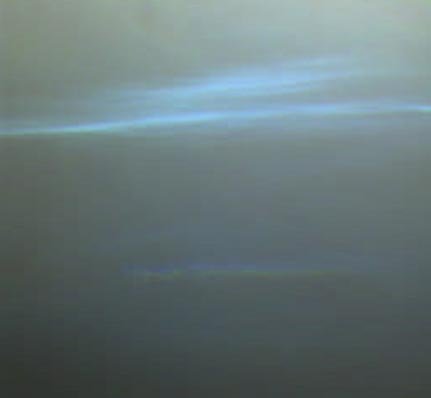
“Mars has clouds too. The above true color image taken in August by Mars Pathfinder shows clouds of ice high in the Martian atmosphere. Unlike Earth's atmosphere which is composed predominantly of nitrogen and oxygen, Mars' atmosphere is composed mostly of carbon dioxide. Nevertheless, a trace amount of water does freeze into visible clouds at night, which become particularly apparent during the day by reflection of sunlight. Contact was lost with Mars Pathfinder last Sunday but re-established later in the week."
Copyright: Public domain
#848 Venus On The Horizon October 14, 1997
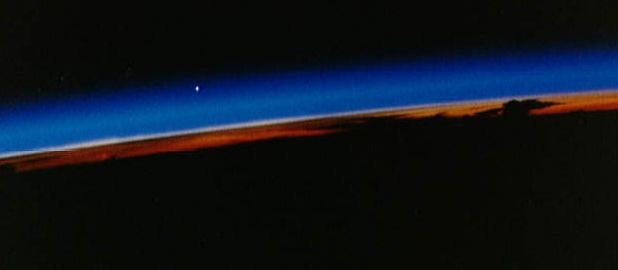
“The month of October features a sky full of planets, including Venus as the brilliant evening star. Besides the sun and moon, Venus is the brightest object visible in Earth's sky. This month, Venus appears in early evening near the red planet Mars and Mars' red giant rival Antares above the southwestern horizon. Because it is closer to the sun than Earth, Venus never strays far from the sun in its apparent position and is seen during the year as either a bright morning or evening star. This beautiful sunset imaged from low earth orbit by the Atlantis space shuttle crew in May 1989 also reveals the planet Venus blazing above Earth's horizon. It is a fitting image for this mission and crew. It was recorded following the successful release of the robot Venus-explorer Magellan, the first planetary probe to be deployed from a space shuttle."
Copyright: Public domain
#849 Cold Wind From The Boomerang Nebula October 15, 1997
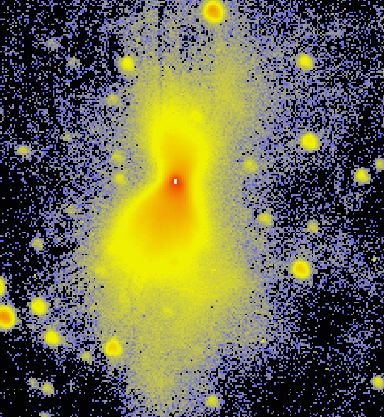
“A cold wind blows from the central star of the Boomerang Nebula. Seen here in a false color image of dust reflected starlight, the nebula lies about 5,000 light-years away. The boomerang shaped cloud appears to have been created by a high-speed wind of gas and dust blowing from an aging central star at speeds of over 300,000 miles per hour. This rapid expansion has cooled the nebular gas to about -458 degrees Fahrenheit or 1 degree above absolute zero, making it the coldest region observed in the distant Universe. The frigid Boomerang nebula represents a unique object for astronomers and is believed to be a star or stellar system evolving toward the planetary nebula phase."
Copyright: Public domain
#850 Cassini To Venus October 16, 1997

“NASA's Saturn Explorer Cassini with ESA's Titan Probe Huygens attached successfully rocketed into the skies early yesterday morning. The mighty Titan 4B Centaur rocket is seen here across the water gracefully arcing away from Launch Complex 40 at Cape Canaveral Air Station. Cassini, a sophisticated, bus-sized robot spacecraft is now on its way ... to Venus, the first planetary way point in its 7 year, 2.2 billion mile journey to Saturn. The mission profile calls for Cassini to swing by Venus during April 1998 and June 1999, Earth in August 1999, and Jupiter in December 2000. During each of these "gravity assist" encounters the six ton spacecraft will pick up energy needed to reach Saturn in July 2004. Cassini's mission is the most ambitious voyage of interplanetary exploration ever mounted by humanity and the Huygens Probe's planned descent to the surface of Titan will be the most distant landing ever attempted."
Copyright: Public domain
#851 Mars: A Mist In Mariner Valley October 17, 1997
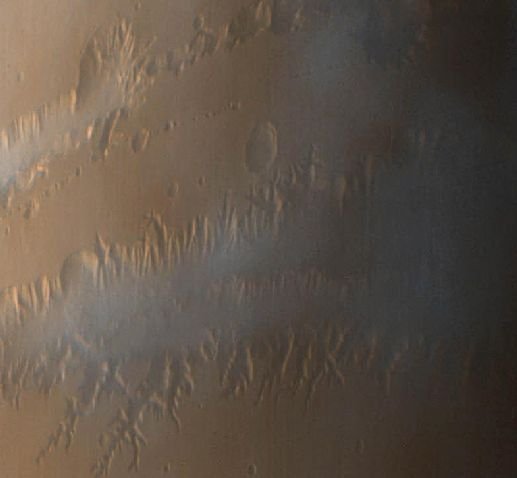
“An icy mist and late afternoon clouds cover much of this section of Valles Marineris on Mars. The Valles Marineris or Mariner Valley is a huge canyon system about 2,000 miles long and up to 5 miles deep. This test image was produced using data from Mars Global Surveyor's wide angle cameras viewing the canyon from a distance of 360-600 miles. Color was synthesized using images recorded through blue and red filters. Mission controllers have recently raised the spacecraft's aerobraking orbit to study the unexpected motion of one of the Surveyor's solar panels."
Copyright: Public domain
#852 The Pleiades Star Cluster October 18, 1997
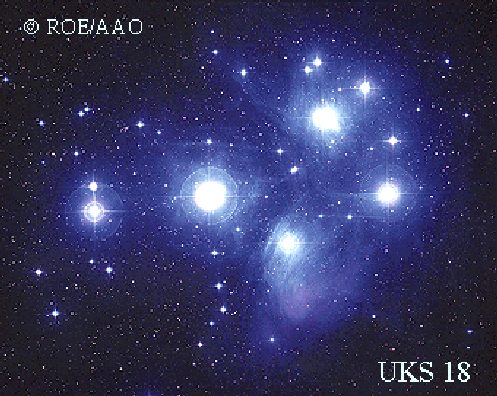
“It is the most famous star cluster on the sky. The Pleiades can be seen without binoculars from even the depths of a light-polluted city. Also known as the Seven Sisters and M45, the Pleiades is one of the brightest and closest open clusters. The Pleiades contains over 3000 stars, is about 400 light years away, and only 13 light years across. Quite evident in the above photograph are the blue reflection nebulae that surround the bright cluster stars. Low mass, faint, brown dwarfs have recently been found in the Pleiades."
Copyright: AAOAATBROEUKS Telescope
#853 The Heart Of NGC 4261 October 19, 1997
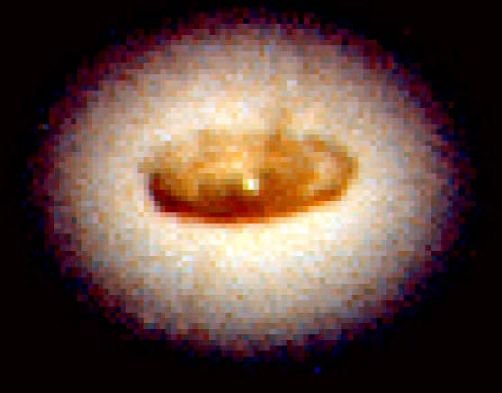
“What evil lurks in the hearts of galaxies? This Hubble Space Telescope picture of the center of the nearby elliptical galaxy NGC 4261 tells one dramatic tale. The gas and dust in this disk are swirling into what is almost certainly a massive black hole. The disk is probably what remains of a smaller galaxy that fell in hundreds of millions of years ago. Collisions like this may be a common way of creating such active galactic nuclei as quasars. Strangely, the center of this fiery whirlpool is offset from the exact center of the galaxy - for a reason that for now remains an astronomical mystery."
Copyright: Public domain
#854 Spiral Eddies On Planet Earth October 20, 1997
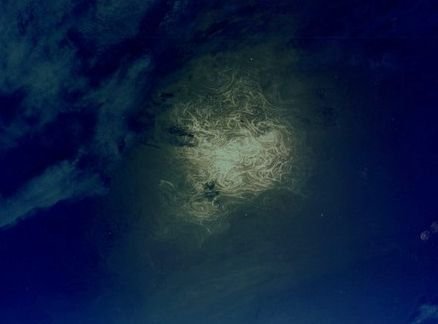
“Can you identify this stellar nebula? How many light-years from Earth did you say? Looking like a twisting cloud of gas and dust between the stars this wispy nebulosity is actually close by - a spiral eddy formed near the North Atlantic Gulf Stream off the East coast of the US. Tens of miles across, spiral eddies are an ocean current phenomenon discovered by observations from manned spacecraft. Imaged by the Challenger space shuttle crew during the STS 41G mission this eddy is dramatically visible due to the low sun angle and strong reflection of sunlight. The reflection is caused by a very thin biologically produced oily film on the surface of the swirling water. Prior to STS 41G these eddies were thought to be rare but are now understood to be a significant dynamic feature of ocean currents. However, no good explanation of their origin or persistence exists."
Copyright: Public domain
#855 The Butterfly Planetary Nebula October 21, 1997
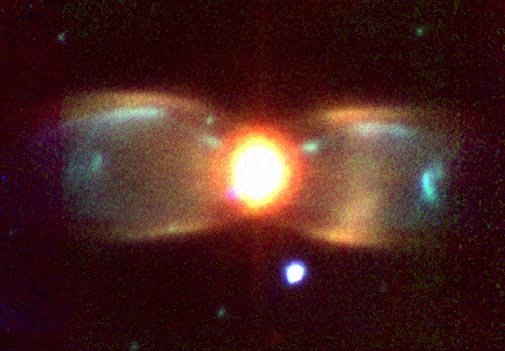
“As stars age, they throw off their outer layers. Sometimes a highly symmetric gaseous planetary nebula is created, as is the case in M2-9, also called the Butterfly. Most planetary nebulae show this bipolar appearance, although some appear nearly spherical. An unusual characteristic of the Butterfly is that spots on the "wings" appear to have moved slightly over the years. The above picture was taken in three bands of infrared light and computationally shifted into the visible. Much remains unknown about planetary nebulae, including why some appear symmetric, what creates the knots of emission (some known as FLIERS), and how exactly stars create them."
Copyright: U. Hawaii2.2-m
TelescopeMauna
Kea
Upvote! Resteem! Comment! As you like it! Thank you for attention!